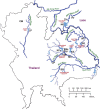Opisthorchiasis and cholangiocarcinoma in Southeast Asia: an unresolved problem
- PMID: 28848361
- PMCID: PMC5557399
- DOI: 10.2147/IJGM.S133292
Opisthorchiasis and cholangiocarcinoma in Southeast Asia: an unresolved problem
Abstract
The prevalence of cholangiocarcinoma (CCA) in Southeast Asia is much higher than other areas of the world. Eating raw, fermented, or undercooked cyprinid fish, infected with the liver fluke, Opisthorchis viverrini sensu lato (sl), results in chronic biliary inflammation, periductal fibrosis, and increased cancer risk. There may be associated glomerulonephritis. The process of infection is difficult to disrupt because eating practices have proven extremely difficult to change, and the life cycle of the fluke cannot be broken due to high prevalence in canine and feline reservoir hosts. Fecal analysis and enzyme-linked immunosorbent assay tests can be used to diagnose opisthorchiasis. Diagnosis of CCA is complex, partly due to the lack of definitive imaging characteristics but also due to the difficulty of obtaining samples for cytology or histology. This cancer has proven to be resistant to common chemotherapy treatments and so the two avenues of treatment available are surgical resection and liver transplantation, both requiring early detection of the tumor for the best chances of success. Late presentation of symptoms reduces the chances of successful surgical intervention. While liver fluke infections can be treated with praziquantel, individuals will often become reinfected, and multiple reinfections can be more harmful than a singular, long-term infection. A key research on the detection and characterization of novel biomarkers in all parts of the carcinogenic pathway for early diagnosis is needed.
Keywords: CCA; Laos; Opisthorchis viverrini; Thailand; carcinogen; helminth; parasite; public health; treatment.
Conflict of interest statement
Disclosure The authors report no conflicts of interest in this work.
Figures


References
-
- Sithithaworn P, Andrews RH, Petney TN, Saijuntha W, Laoprom N. The systematics and population genetics of Opisthorchis viverrini sensu lato: implications in parasite epidemiology and bile duct cancer. Parasitol Int. 2012;61(1):32–37. - PubMed
-
- Kiatsopit N, Sithithaworn P, Saijuntha W, Petney TN, Andrews RH. Opisthorchis viverrini: implications of the systematics of first intermediate hosts, Bithynia snail species in Thailand and Lao PDR. Infect Genet Evol. 2013;14:313–319. - PubMed
Publication types
Grants and funding
LinkOut - more resources
Full Text Sources
Other Literature Sources

